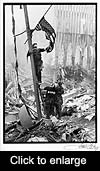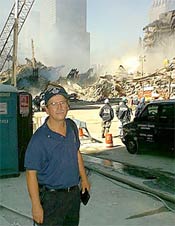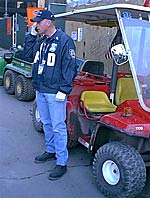|
|
|
|
MCKINSEY REPORT ON THE NYPD
The report went on to give the caveat: “The NYPD asked McKinsey to facilitate this review as an objective fact gatherer and observer, not as an expert in emergency response.” Such a caveat was placed at the beginning of this report for very good reasons. Let me also give a caveat prior to writing my comments about the McKinsey Report. I do not seek to give negative criticism of the report. I only want to offer some constructive criticism. I read the report with a mindset that looked for a certain group of words. Those words are the following: “INCIDENT COMMAND SYSTEM”. I was disappointed. Nowhere in this report were those words to be found. I had already read the McKinsey Report on the Fire Department of the City of New York. That report was filled with references to the need for adoption and utilization of the Incident Command System (ICS) . The State of New York has mandated that this system be made the template for all emergency operations. See the Governor’s executive order: I have written previous articles about the critical need for adoption of the Incident Command System (ICS)
by ALL emergency services. Click here to read an article:
AT GROUND ZERO IN NEW YORK CITY
He is a qualified expert in Critical Incident Stress Debriefing. Trauma counseling was an important area of his expertise. Yet, I
know that the enormity of the destruction dwarfed any previous traumatic incidents that he or other experts in CISD had ever experienced. As we walked the short
distance down Liberty Street to Trinity Place, I glanced at the building on the southwest corner. Their dust encrusted faces and helmets identified them as early veterans of the new “War on Terror”. There will be many more such veterans before this new war is over. I mentioned to Tim about how important it would be that these rescue workers undergo debriefing as often as possible. He told me about the program for cops that had been set up with POPPA. (Police Officers Peers Providing Assistance). The FDNY would also have a similar program. http://www.nycop.com/Stories/Dec_00/Critical_Incident_Stress/critical_incident_stress.html The huge pile of debris that had been the World Trade Center and the heavily damaged buildings on the perimeter created a feeling that was reminiscent of standing inside a huge crater. The still-smoldering “Pile” completed the volcanic-like scenario. I looked up at One Liberty Plaza on the corner of Liberty Street and Church Street. Much of the face of the building had sustained damage. North of One Liberty Street stood the Century 21 Department Store and the Millenium Hotel. Both of those buildings were also damaged when the towers collapsed. Tim warned that at the sound of an alarm, all the rescue workers would run from “The Pile”. He pointed to the large windows on the surrounding buildings and recalled how some of the windows had popped out of their frames and fell like deadly leaves to the ground below. Tim next introduced me to some of the volunteers from around the Nation who had responded to New York City with the FEMA, the Federal Emergency Management Agency . We went to the nearby Church Street Cache that served as the supply base for the Church Street Sector. For those who are not familiar with Incident Command System (ICS) terminology, a cache is a logistic supply location for a designated sector. I met Ernie Smith of the Texas Forest Service and Steve Hayden, Trail Crew Supervisor, United States Forest Service. Both of these men were acting as the Receiving and Distribution managers at the Church Street Cache. The temporary trailer was filled with supplies such as helmets, boots, gloves, and other supplies needed by the rescue workers. Smith was from Texas and Hayden was from Oregon. Both of these men were experienced in the Incident Command System.
L to R: PO Tim O’Neill, Ernie Smith, Steven Hayden
THE INCIDENT COMMAND SYSTEM IN ACTION IN NEW YORK CITY “Urban Search and Rescue Teams” (USAR) from around the Nation were assisting in the rescue attempts. The Incident Commander and his staff had established their Incident Command Post ten blocks north of Ground Zero in Fire Department facilities on Duane Street between Broadway and Church Street. FDNY Engine 7 and Ladder 1 occupied that location as well. The “ICP” was where all primary command functions were executed. However, the Incident “Base” was located at what was named “Hilton Base” in Mid-town Manhattan. The “Incident Base” is the location where primary logistics functions are coordinated. Are you confused by the terminology? You thought that you were up to date in police lingo? Guess again. Unless you are versed in the new language of emergency management, you will be hard pressed to fit into the system. We all know that the use of acronyms by those inside of any system identifies those who are active members of that system. Ignorance of those acronyms identifies those who are not. The terminology of the Incident Command System (ICS) is filled with such acronyms. Would you know where the “RESTAT” unit was located? Or the “SITSTAT” unit? Would you know what the acronym “C3I” signifies? Or do you know what “METTAG” refers to? The Incident Command System (ICS) also has its own terminology.
Recently, I again met him at the US Custom’s House in Manhattan during the World Trade Center Building Code Task Force hearings.
Copyright © 2002 Edward D. Reuss
|
|||
 |
||||||||||
 |
||||||||||
 A global consulting firm with offices here in New York City published a report
on the actions of the New York City Police Department during the attack on the World Trade Center on
A global consulting firm with offices here in New York City published a report
on the actions of the New York City Police Department during the attack on the World Trade Center on  On
On  I met
I met 
 Emergency Management requires that ALL branches of
emergency services be well versed in the same terminology. Unity of command, span of control, and delegation of authority requires that all be on the same page when it comes to such emergency management.
Emergency Management requires that ALL branches of
emergency services be well versed in the same terminology. Unity of command, span of control, and delegation of authority requires that all be on the same page when it comes to such emergency management.